So, I have recently gone back online and while what I am writing about Tarot is consistent with my general attitude, that taking anything seriously is a serious error, I have encountered something which I thought might just interest this forum. Perhaps you all have addressed this and adequately answered it. But I have not seen anything about it, so I thought I would link my article and I will entertain comments and questions here.
The key point or question I have, and which I explore in the article, is how we really know what we claim to know. Fake news and fake evidence—or let us just say dubious evidence, maybe altered with good intentions, these things plague research into fast-fading artifacts, like The Tarocchi Players.
Anyway, perhaps at least you will find this a divertissement.
https://pathologypoet.substack.com/p/th ... hi-players
Re: Tarocchi Players of Palazzo Borromeo
2hi, welcome again ...
The first "trionfi" with playing card context is meanwhile from September 16 in 1440 and the used words were "un paio di naibi a trionfi" ....
The Pratesi article STUDIES ON GIUSTO GIUSTI, 09.07.2012, has the details ....
http://trionfi.com/giusto-giusti
Giusto Giusti wrote in his diary ....
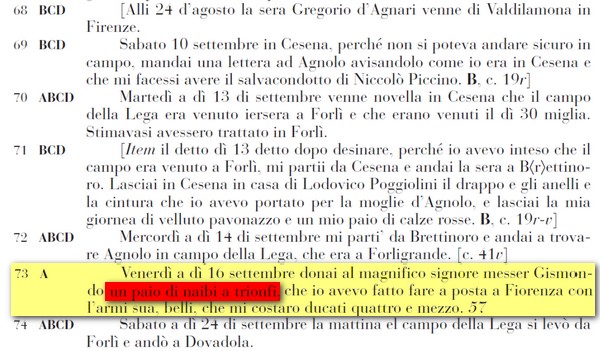
Nerida Newbigin worked on the Giusto-Giusti text, Thierry Depaulis detected the passage.
... :-) ... Nerida once made this remark to us: "The world of Trionfi has taken more notice of my work than the rest of Italianistica put together, and I am glad to have contributed something."
The first "trionfi" with playing card context is meanwhile from September 16 in 1440 and the used words were "un paio di naibi a trionfi" ....
The Pratesi article STUDIES ON GIUSTO GIUSTI, 09.07.2012, has the details ....
http://trionfi.com/giusto-giusti
Giusto Giusti wrote in his diary ....

Nerida Newbigin worked on the Giusto-Giusti text, Thierry Depaulis detected the passage.
... :-) ... Nerida once made this remark to us: "The world of Trionfi has taken more notice of my work than the rest of Italianistica put together, and I am glad to have contributed something."
Huck
http://trionfi.com
http://trionfi.com
Re: Tarocchi Players of Palazzo Borromeo
3Thanks very much, Glenn Wright, for your insightful and entertaining discussion at https://pathologypoet.substack.com/p/th ... layers?s=r
Rosini's drawing was a discovery for me. You are probably right that it is new to Tarot history. I could not find an earlier edition of Storia della pittura italiana. There was a second edition in 1850, so the 1841 edition of volume 3 must be the first. (Giovanni Rosmini Storia della pittura italiana volume 3 1850 2nd edition
https://resources.warburg.sas.ac.uk/pdf ... 3660v3.pdf
After page 210 for Tarocchi Players drawing )
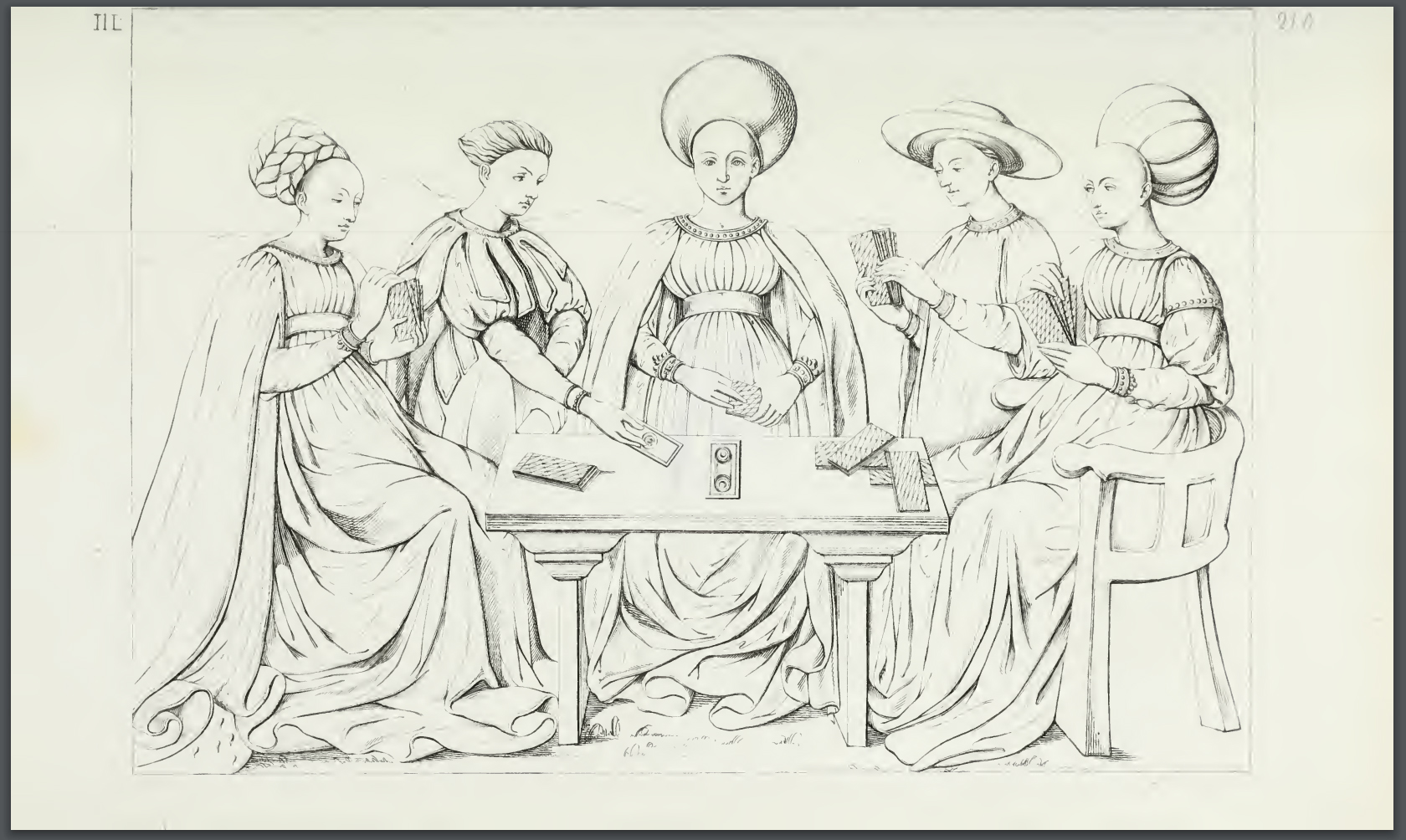
I found some other pre-war photographs, which helped me figure out what I believe is going on in the game depicted. From a Facebook post of last year:
There's much more than meets the eye in the famous fresco of the Tarocchi Players in the Palazzo Borromeo, Milan, dating to the mid-1440s. It shows the dynamics of a real round of play, for instance. The painter knew the game.
The condition of the fresco has deteriorated since it was first photographed, by Osvaldo Lissoni in 1925. Raimond van Marle published it in The Development of the Italian Schools of Painting, volume VII, 1926. While the online version of this book shows enough detail to make some observations, it appears that the photographs have been published elsewhere as well.
Here's my analysis of the movement of the scene:
1 - The central, majestic, woman, has led the 2 of Coins.
2 - The man to her right (counterclockwise, the traditional directlon of play), is in the act of following suit with the Ace of Coins, beating her card (in the suits of Coins and Cups, 10 is low and Ace is high).
The next woman, 3, is considering which card to play; since the artist depicts the 3 of Cups and another Cups behind it, it seems we are to assume she cannot follow suit and will therefore lose this trick.
Across the table, 4 is looking at 3 with supreme confidence, waiting for her to play. She has already selected the card she intends to play, as if knowing that her opponent cannot follow suit.
The last man, 5, is studying his hand, we don't know what he has.
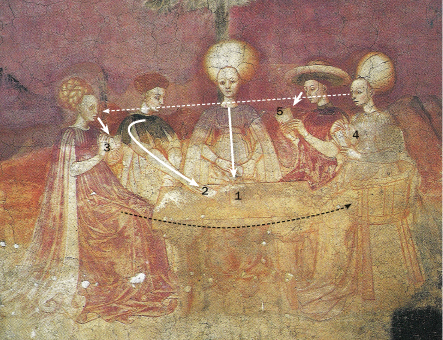
Woman on our left, holding a 3 of Cups, another possibly behind it, riffling through her cards to decide what to do (Lissoni black and white, modern picture) -
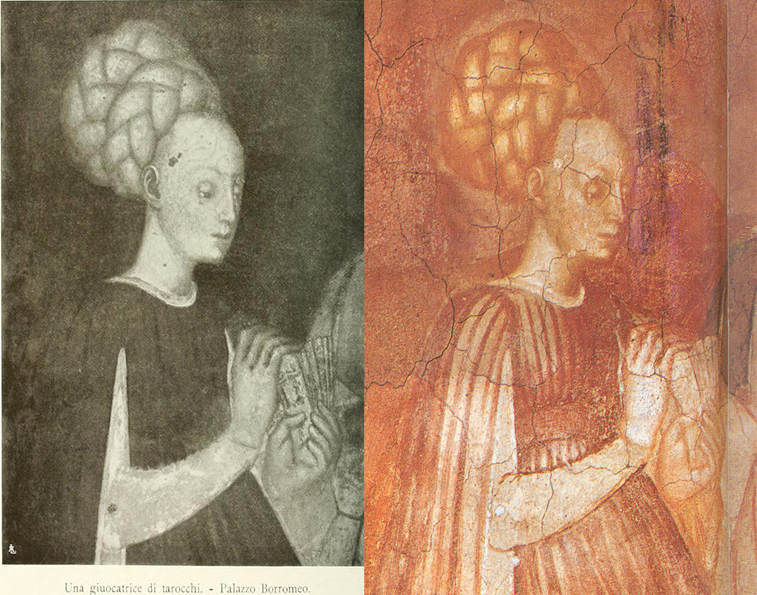
Woman across the table from her, looking at her opponent, having already decided what she will play -
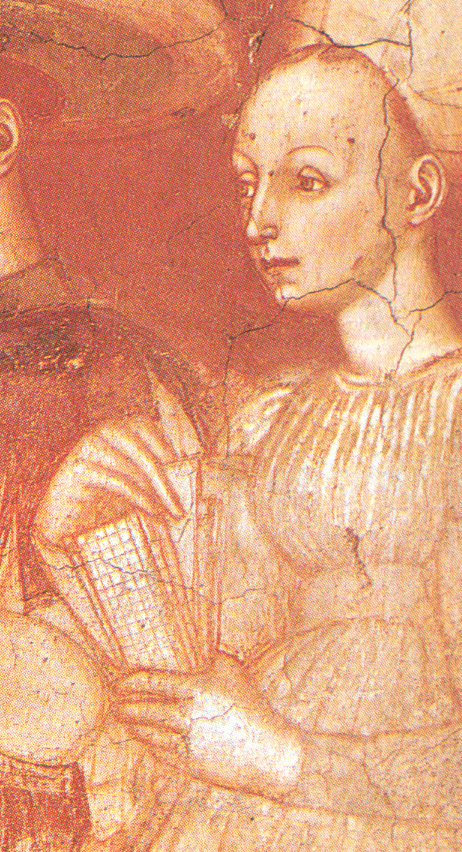
Lissoni's full photograph of the scene, in the online version of Van Marle's The Development of the Italian Schools of Painting, vol. VII, page 145. The led 2 of Coins and the man's Ace of Coins can be seen -
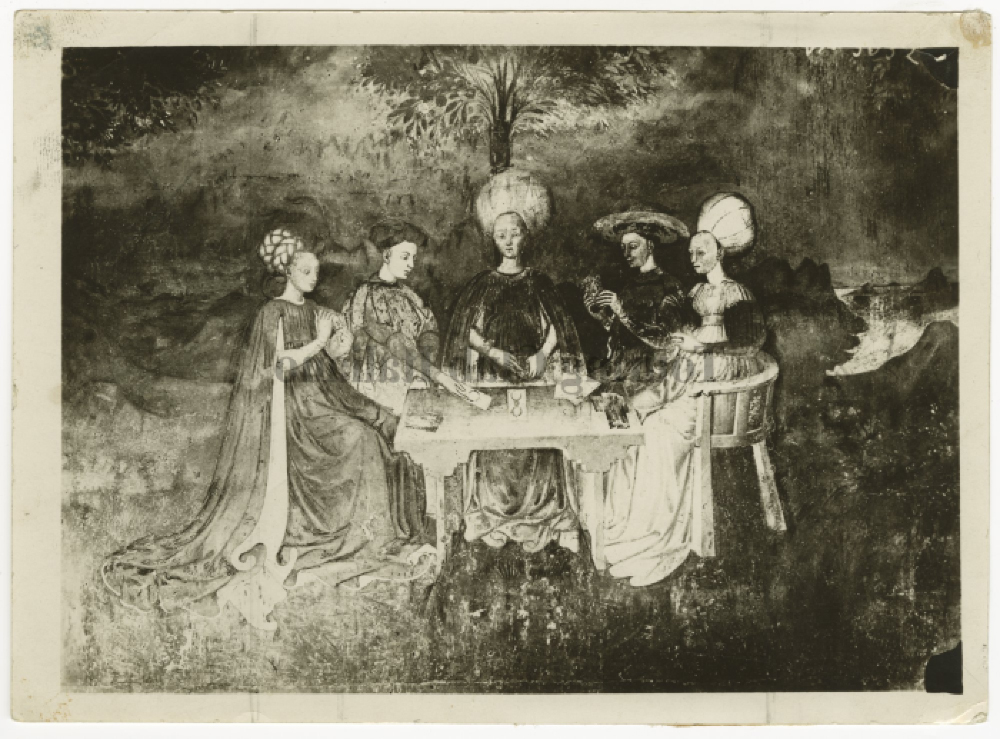
Winifred Terni de Gregori's biography Bianca Maria Visconti (Bergamo, 1940), contains a detail from the Palazzo Borromeo fresco (page 84). Taken before the war, the photograph this detail is taken from preserves fine features of the fresco now lost.
The backs of the cards contain a much more ornate pattern than the simple crossed lines visible today. More striking are the piles of won tricks in front of the two players on the right, which are completely gone today. Because they laid the won tricks crosswise, it seems that we can see that the lady on the right has won two tricks, five cards per trick, thus 10 cards. The man following her seems to have won three, judging by the three ends which seem to be visible in the poor reproduction from Marle's book. The lady across from this one, has one trick in front of her. Thus 30 cards have been played, six tricks, and two are currently in play (Ace and 2 of Denari) in the seventh round (we are thus in the middle of the game, an elegant choice on the part of the artist). On the other hand it is possible that the three cards to the central lady's left are her three discarded cards, assuming she is the dealer. Since 78 divided by 5 is 15 with 3 remaining, the dealer would have three cards to exchange, or discard, in this scenario. Only a better view of this part of the table would clear up how many cards are actually in that pile, though.
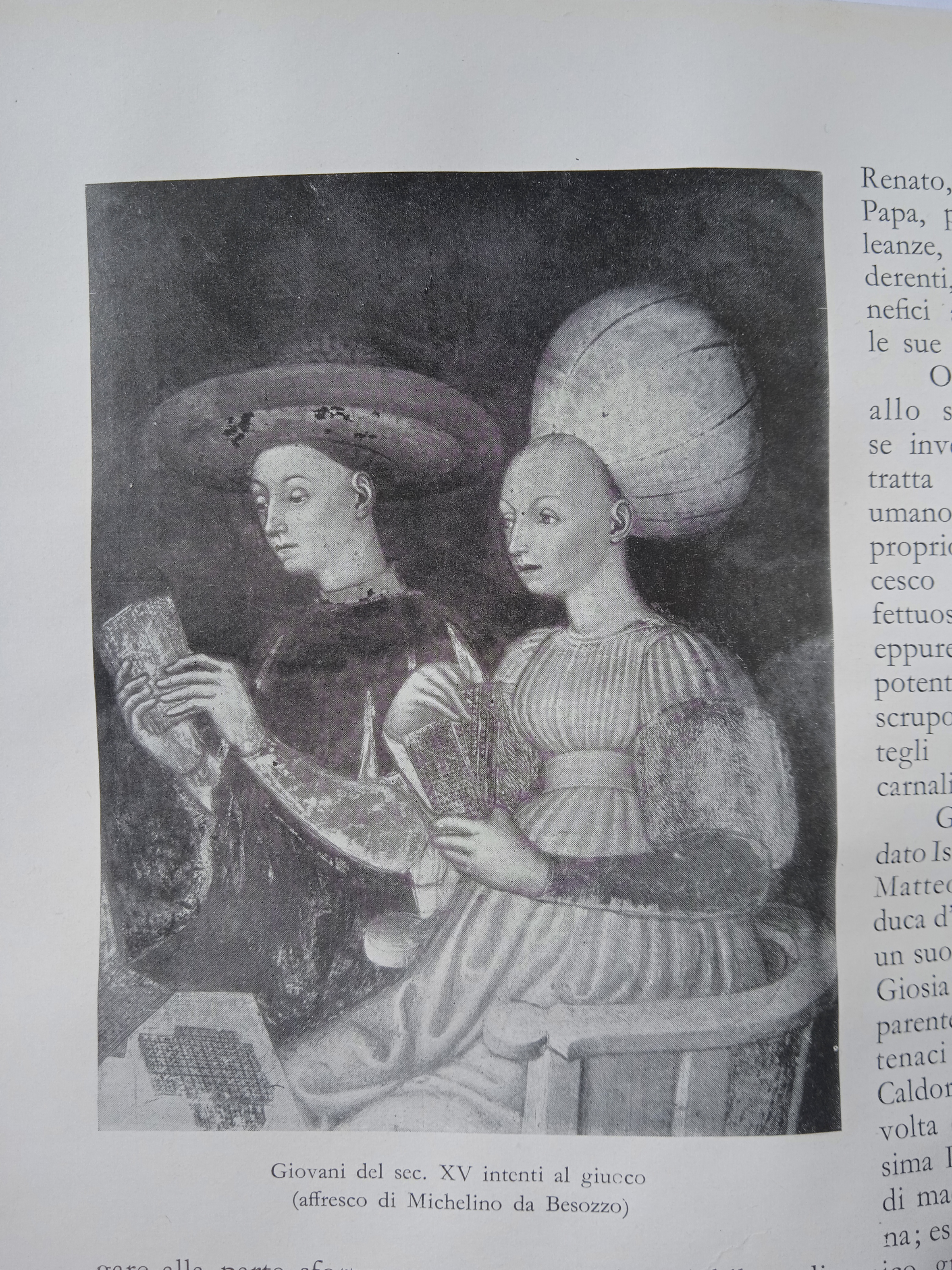
Addendum
Thanks to Glenn Wright's discovery of the drawing of the fresco in Giovanni Rosini's Storia della pittura italiana, volume 3 (1841), between pages 274-275, we can clarify that the young man playing last to the trick has won only two tricks, not three like I wrote above. This means that they are now playing the sixth round out of probably 15 (The young man's cards are not placed quite as snugly up to the lady's in the photograph as compared to the drawing, however, and the lady across the table riffling through her cards clearly has Cups visible, while the drawing just depicts it as a generic back-pattern).
Rosini's drawing was a discovery for me. You are probably right that it is new to Tarot history. I could not find an earlier edition of Storia della pittura italiana. There was a second edition in 1850, so the 1841 edition of volume 3 must be the first. (Giovanni Rosmini Storia della pittura italiana volume 3 1850 2nd edition
https://resources.warburg.sas.ac.uk/pdf ... 3660v3.pdf
After page 210 for Tarocchi Players drawing )

I found some other pre-war photographs, which helped me figure out what I believe is going on in the game depicted. From a Facebook post of last year:
There's much more than meets the eye in the famous fresco of the Tarocchi Players in the Palazzo Borromeo, Milan, dating to the mid-1440s. It shows the dynamics of a real round of play, for instance. The painter knew the game.
The condition of the fresco has deteriorated since it was first photographed, by Osvaldo Lissoni in 1925. Raimond van Marle published it in The Development of the Italian Schools of Painting, volume VII, 1926. While the online version of this book shows enough detail to make some observations, it appears that the photographs have been published elsewhere as well.
Here's my analysis of the movement of the scene:
1 - The central, majestic, woman, has led the 2 of Coins.
2 - The man to her right (counterclockwise, the traditional directlon of play), is in the act of following suit with the Ace of Coins, beating her card (in the suits of Coins and Cups, 10 is low and Ace is high).
The next woman, 3, is considering which card to play; since the artist depicts the 3 of Cups and another Cups behind it, it seems we are to assume she cannot follow suit and will therefore lose this trick.
Across the table, 4 is looking at 3 with supreme confidence, waiting for her to play. She has already selected the card she intends to play, as if knowing that her opponent cannot follow suit.
The last man, 5, is studying his hand, we don't know what he has.

Woman on our left, holding a 3 of Cups, another possibly behind it, riffling through her cards to decide what to do (Lissoni black and white, modern picture) -

Woman across the table from her, looking at her opponent, having already decided what she will play -

Lissoni's full photograph of the scene, in the online version of Van Marle's The Development of the Italian Schools of Painting, vol. VII, page 145. The led 2 of Coins and the man's Ace of Coins can be seen -

Winifred Terni de Gregori's biography Bianca Maria Visconti (Bergamo, 1940), contains a detail from the Palazzo Borromeo fresco (page 84). Taken before the war, the photograph this detail is taken from preserves fine features of the fresco now lost.
The backs of the cards contain a much more ornate pattern than the simple crossed lines visible today. More striking are the piles of won tricks in front of the two players on the right, which are completely gone today. Because they laid the won tricks crosswise, it seems that we can see that the lady on the right has won two tricks, five cards per trick, thus 10 cards. The man following her seems to have won three, judging by the three ends which seem to be visible in the poor reproduction from Marle's book. The lady across from this one, has one trick in front of her. Thus 30 cards have been played, six tricks, and two are currently in play (Ace and 2 of Denari) in the seventh round (we are thus in the middle of the game, an elegant choice on the part of the artist). On the other hand it is possible that the three cards to the central lady's left are her three discarded cards, assuming she is the dealer. Since 78 divided by 5 is 15 with 3 remaining, the dealer would have three cards to exchange, or discard, in this scenario. Only a better view of this part of the table would clear up how many cards are actually in that pile, though.

Addendum
Thanks to Glenn Wright's discovery of the drawing of the fresco in Giovanni Rosini's Storia della pittura italiana, volume 3 (1841), between pages 274-275, we can clarify that the young man playing last to the trick has won only two tricks, not three like I wrote above. This means that they are now playing the sixth round out of probably 15 (The young man's cards are not placed quite as snugly up to the lady's in the photograph as compared to the drawing, however, and the lady across the table riffling through her cards clearly has Cups visible, while the drawing just depicts it as a generic back-pattern).
Re: Tarocchi Players of Palazzo Borromeo
4The other thing I didn't know about was Lionel Cust's 1918 article in the Burlington Magazine (Volume 33, number 184, pp. 8-14).
https://ur.booksc.eu/book/49547057/eda5bc
Cust doesn't name the photographer, but it is a few years earlier than Lissoni's, which were probably taken in 1925.
Here is the best screengrab I can get from the online article -
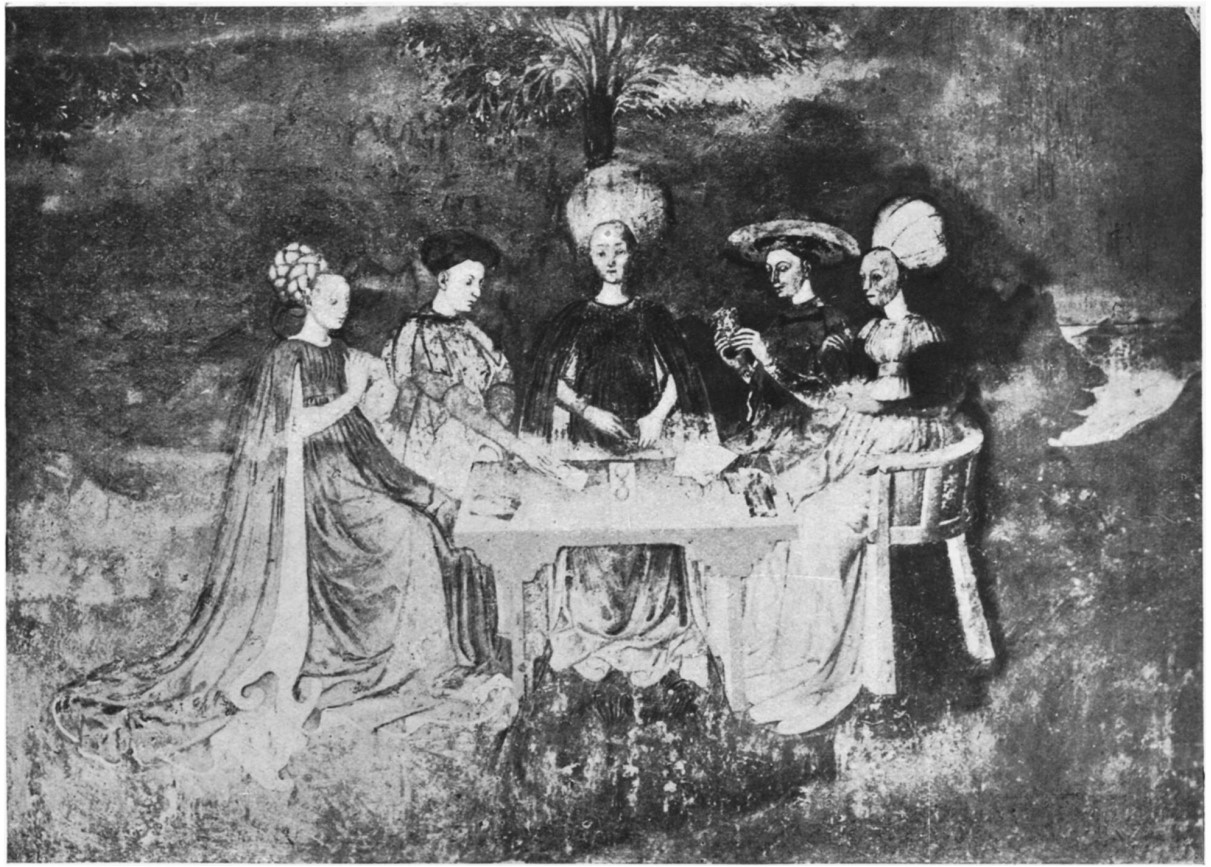
https://ur.booksc.eu/book/49547057/eda5bc
Cust doesn't name the photographer, but it is a few years earlier than Lissoni's, which were probably taken in 1925.
Here is the best screengrab I can get from the online article -

Re: Tarocchi Players of Palazzo Borromeo
5I hate to rain on everyone's parade here, but it really doesn't look like they are playing tarot at all, does it?
None of the cards visible in the surviving images are tarot-specific. They are apparently all numeral cards, with the exception of one picture card in the hand of the woman on the far left, which is apparently just visible as the card behind the cups card (according to p. 78 of the Tarots Enluminés catalog). It is not possible to identify which figure it is. (I'm not sure what image the Tarots Enluminés author was looking at; I can't identify any of her cards except that cups card.) If the painter wanted to paint a picture of a tarot game, surely a trump would be clearly visible somewhere.
Moreover, five is not the number of players you would expect in a game of tarot at this time. All the evidence we have indicates that the game of tarot was originally for designed for three or four players. Five is extremely unlikely at this stage.
Both of these points have already been made by others. To these two points, we can add a further observation: The number of cards visible in the surviving images is too low for tarot. I'm not sure why Ross thinks there could be three tricks in front of the man on the right of the picture; I see only two, for a total of five tricks on the table—possibly four if the cards in front of the woman on the far left are a discard, not a trick, but they look too numerous for that. The players appear to have six cards remaining in their hands (certainly not ten, as one would expect from a 78-card tarot deck). If five tricks have been played (5 x 5 cards = 25) and six cards remain in their hands (5 x 6 = 30), then there are a total of 55 cards in play. This would correspond very well to a standard 56-card deck (with four courts in each suit, including queens) with an initial discard of just one card (not shown in the painting). If the cards on the table in front of the woman on the far left were not a trick but rather a discard of two cards, it could have been a standard 52-card deck (with three courts in each suit) but the 1841 drawing makes it look like there are more cards there than two, so it is more likely to be a trick that she has won.
Even if Ross is right about the man on the right having three tricks on the table, that still only gives 60 cards. That could be something like an Imperatori deck perhaps, but it's certainly far too few for any tarot deck that is likely to have existed in the mid-fifteenth century.
To my mind, the reason this painting came to be called The Tarocchi Players is probably because Milan switched over to French-suited cards for its regular decks centuries ago, so from that point on, the Italian suits were used in Milan only in tarot decks. So when people saw Italian-suited cards in the picture, they assumed they must be tarot cards. In much the same way, French people have sometimes inaccurately called Italian-suited standard decks "tarot decks" because of their similar appearance to the suit cards of the Tarot de Marseille, and until relatively recently it was quite common in Germany for even playing-card specialists to refer to all Italian-suited decks as "Trappola decks" because those were the only kind of Italian-suited decks generally known in Germany.
It's a beautiful and fascinating painting, but it's almost certainly not a picture of a game of tarot.
None of the cards visible in the surviving images are tarot-specific. They are apparently all numeral cards, with the exception of one picture card in the hand of the woman on the far left, which is apparently just visible as the card behind the cups card (according to p. 78 of the Tarots Enluminés catalog). It is not possible to identify which figure it is. (I'm not sure what image the Tarots Enluminés author was looking at; I can't identify any of her cards except that cups card.) If the painter wanted to paint a picture of a tarot game, surely a trump would be clearly visible somewhere.
Moreover, five is not the number of players you would expect in a game of tarot at this time. All the evidence we have indicates that the game of tarot was originally for designed for three or four players. Five is extremely unlikely at this stage.
Both of these points have already been made by others. To these two points, we can add a further observation: The number of cards visible in the surviving images is too low for tarot. I'm not sure why Ross thinks there could be three tricks in front of the man on the right of the picture; I see only two, for a total of five tricks on the table—possibly four if the cards in front of the woman on the far left are a discard, not a trick, but they look too numerous for that. The players appear to have six cards remaining in their hands (certainly not ten, as one would expect from a 78-card tarot deck). If five tricks have been played (5 x 5 cards = 25) and six cards remain in their hands (5 x 6 = 30), then there are a total of 55 cards in play. This would correspond very well to a standard 56-card deck (with four courts in each suit, including queens) with an initial discard of just one card (not shown in the painting). If the cards on the table in front of the woman on the far left were not a trick but rather a discard of two cards, it could have been a standard 52-card deck (with three courts in each suit) but the 1841 drawing makes it look like there are more cards there than two, so it is more likely to be a trick that she has won.
Even if Ross is right about the man on the right having three tricks on the table, that still only gives 60 cards. That could be something like an Imperatori deck perhaps, but it's certainly far too few for any tarot deck that is likely to have existed in the mid-fifteenth century.
To my mind, the reason this painting came to be called The Tarocchi Players is probably because Milan switched over to French-suited cards for its regular decks centuries ago, so from that point on, the Italian suits were used in Milan only in tarot decks. So when people saw Italian-suited cards in the picture, they assumed they must be tarot cards. In much the same way, French people have sometimes inaccurately called Italian-suited standard decks "tarot decks" because of their similar appearance to the suit cards of the Tarot de Marseille, and until relatively recently it was quite common in Germany for even playing-card specialists to refer to all Italian-suited decks as "Trappola decks" because those were the only kind of Italian-suited decks generally known in Germany.
It's a beautiful and fascinating painting, but it's almost certainly not a picture of a game of tarot.
Re: Tarocchi Players of Palazzo Borromeo
6"but it really doesn't look like they are playing tarot at all, does it"
What would it look like if they were really playing tarot?
If you say, oh a bunch of trumps would be clearly visible, I would say maybe they were once upon a time. This image has been much altered, which was one of my points. I would also say, maybe identifying the deck as Tarot or any specific deck was neither the object nor was it necessary. The point is that it was a trick-taking game, and since we know the timeframe of the painting, it is reasonable to think it was tarot. That was the game, or really games, of the moment.
I think it would be helpful for everyone to recall something. The painting achieves a number of purposes, but it is mainly a statement of status for the family paying to have it made. And they are not going to have their richly attired young folk playing with some grubby street cards or card games that do not match the status of the players.
As for the number of players, what book of rules for this time and place says Tarot games cannot have five players?
Additionally, on that point and regarding how many tricks or cards have been played, again it is a painting, a suggestive exercise.
It is not a sports documentary.
What would it look like if they were really playing tarot?
If you say, oh a bunch of trumps would be clearly visible, I would say maybe they were once upon a time. This image has been much altered, which was one of my points. I would also say, maybe identifying the deck as Tarot or any specific deck was neither the object nor was it necessary. The point is that it was a trick-taking game, and since we know the timeframe of the painting, it is reasonable to think it was tarot. That was the game, or really games, of the moment.
I think it would be helpful for everyone to recall something. The painting achieves a number of purposes, but it is mainly a statement of status for the family paying to have it made. And they are not going to have their richly attired young folk playing with some grubby street cards or card games that do not match the status of the players.
As for the number of players, what book of rules for this time and place says Tarot games cannot have five players?
Additionally, on that point and regarding how many tricks or cards have been played, again it is a painting, a suggestive exercise.
It is not a sports documentary.
Re: Tarocchi Players of Palazzo Borromeo
7You're welcome. Glad it added something. I do think this question of how we know it's Tarot is worth discussing. I am not sure analyzing what number of cards is on the table or not on the table is going to get us very far along. The central figures of the painting are the people, not the cards. For our purposes, we are lucky we have suggestions the cards once played a more prominent role. It helps move us towards being able to say: well, here are these people (Milanese nobles) making these cards, and here are the cards they made, and the painting shows these same people playing games with these cards.
I think the burden of proof falls more on people wanting to say—it isn't Tarot in the painting.
People these days need to have a caption on all their images like "THIS PAINTING SHOWS US PLAYING TAROT—WE HAD A BLAST!"
Again, there might once have been such a label, but I don't think they needed it.
Re: Tarocchi Players of Palazzo Borromeo
8It does, though, which is why it has acquired the traditional name. Rosini 1841 is the earliest attestation I've seen now, and he calls it "Giuoco dei Tarocchi."Nathaniel wrote: 13 Apr 2022, 10:30 I hate to rain on everyone's parade here, but it really doesn't look like they are playing tarot at all, does it?
But yes, it might not be Tarocchi. Tarot historians since Dummett have pointed out that no trumps are visible, although he thinks the splotches on the cards of the right-hand side players in the old photographs of Lissoni (and the same on Cust's) might show "the Matto or a Queen" (Game of Tarot, p. 68). From Terni di Gregori's photograph we can see that the card was turned face downwards, and only the back-pattern can be seen.
We can't assume that. The setting might be enough to indicate what game it was. What seems so necessary to us may not have occurred to them at all. About the trumps, Gertrude Moakley pointed out in 1956 the annoying fact of "the original absence of curiosity about their meaning, showing that it must have been taken for granted."If the painter wanted to paint a picture of a tarot game, surely a trump would be clearly visible somewhere.
In any case, whether it was Tarot or not, the fresco is not critical proof of anything. We know that Tarot existed already, and that rich people played it. Whether we believe it is a game of Tarot or not doesn't matter.
One lost fresco explicitly depicting noble ladies playing Triumphs is consistent with the Borromeo one being this game, though. In 1469 Galeazzo Maria Sforza commissioned Bonifacio Bembo to complete an ambitious fresco cycle in the castle at Pavia. See Evelyn Welch, "Galeazzo Maria Sforza and the Castello di Pavia, 1469," The Art Bulletin, 71:3 (1989), pp. 352-375 https://ur.booksc.eu/book/34581012/c1f89a
"The next fresco in the duchess's suite was for a saletta ove manzano le donne [G] in the loggia, the first overt indication of a room's function. But the fresco there makes little reference to dining, warning against assumptions that the paintings necessarily reflected the purpose of each room. Here, the new bride, her sister-in-law Elisabetta and other members of her court were shown playing a feminine version of balla, the game of poma, palma, or tarot cards, al triumpho. These subjects were popular decorative themes in Lombard palaces. All three games are depicted in the Giochi Borromei in the Palazzo Borromeo in Milan. Palma also appears in the Palazzo Zoppi in Alessandria. They may also have been considered particularly suitable for women's quarters. For example, a sala de la palla, recorded in the Sforza palace in Pesaro from 1442 to 1476, was generally assigned to Sforza brides and formed part of Costanza d'Aragona's suite. But the only aspect of the Pavian fresco that related to the room's function as a dining room was an odd final vignette of a dwarf bringing mushrooms to the duchess." (page 365)
Image of the placement of the rooms in the destroyed NE wall of the castle:
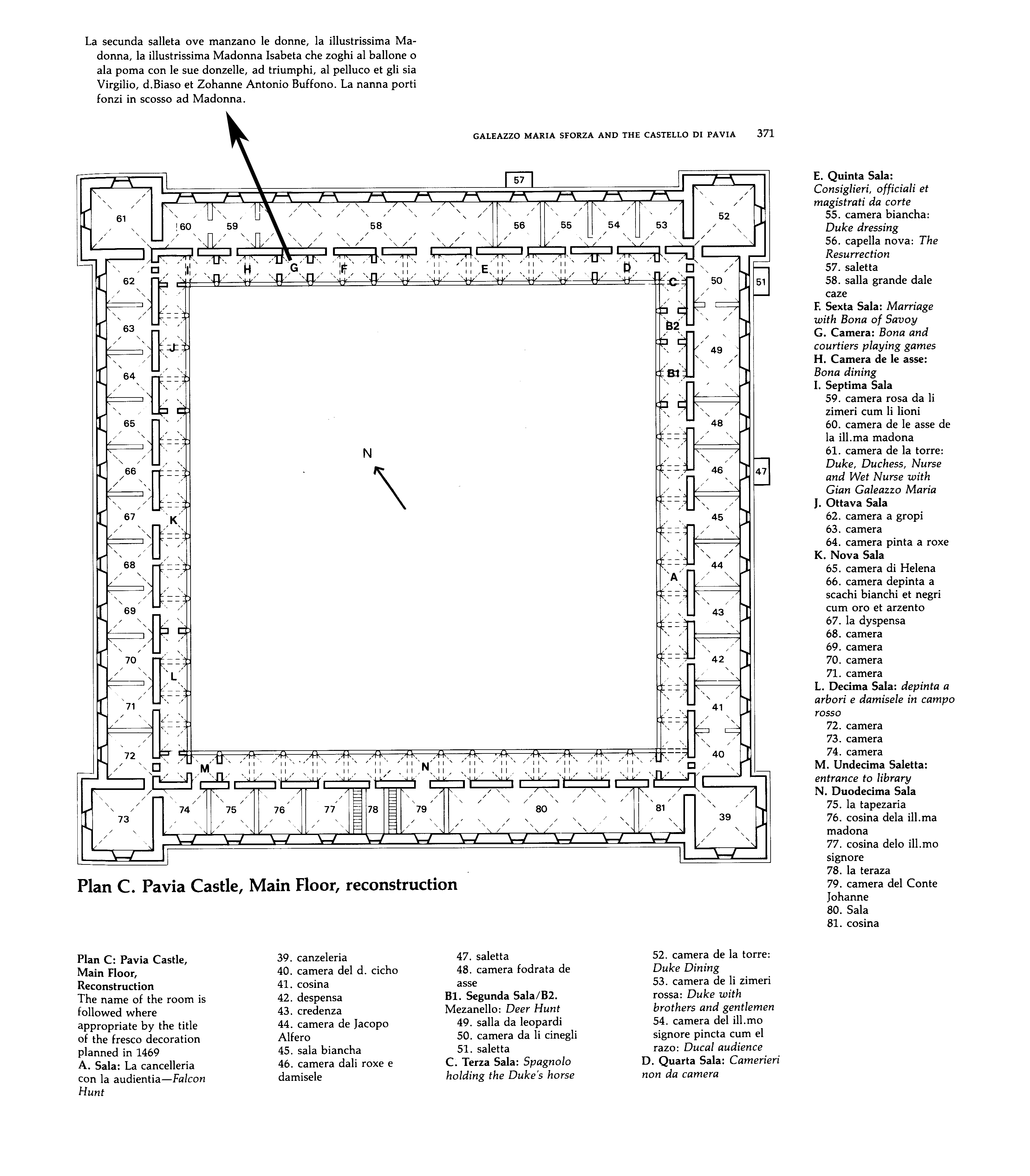
For myself, I'm content that the Borromeo fresco is consistent with a game of Trionfi, visible trumps or not.
Whatever ideal number of players the game was created for, they surely had the creative imagination to adapt the game to the number of people present and willing to play.Moreover, five is not the number of players you would expect in a game of tarot at this time. All the evidence we have indicates that the game of tarot was originally for designed for three or four players. Five is extremely unlikely at this stage.
It is possible that Trionfi games for two players already existed by the early 1440s. On 3 January 1444 Giovanni di Ser Piero and Vieri di Nanni were arrested for playing charte a trionfi in the San Simone neighbourhood of Florence (http://naibi.net/A/78-CARDS.pdf, pp. 3-4). Pratesi notes, however, that usually in these records only one person was apprehended and fined, so it is uncertain how many total players of a game there were on a given occasion, if one or more managed to escape.
The earliest explicit evidence for the number of players is from Ugo Trotti's De multiplici ludo, 1456, when he mentions Triumphs as game of four in two partnerships -
"Ex hiis infertur quid de ludo cartarum qui hodie multum frequentatur, qui tamen multiplex est et quandoque plus habet industrie quam fortune. Veluti si quattuor bipertiti ludant ad triumphos."
The game of cards, which today is very popular, stands out from these other games (previously mentioned), because it is varied and depends more on skill than on luck, as if four in two pairs should play triumphs.
The “veluti si” always struck me as implying that he knew of other kinds of Trionfi games, not depending quite so much on skill.
It is also possible to imagine that a completely different kind of Trionfi is being portrayed in the fresco. For instance, the central figure might be a kind of dealer-bank who is not playing, but who deals the top card which the others must play to, following suit if possible, etc. So there are actually only four players in a given round, and the deal, presumably, goes around. We cannot guess how many cards of the “bank” she is holding back.
You'll note that I corrected myself from three to two, based on Rosini's drawing, in the "Addendum" to my post above.Both of these points have already been made by others. To these two points, we can add a further observation: The number of cards visible in the surviving images is too low for tarot. I'm not sure why Ross thinks there could be three tricks in front of the man on the right of the picture; I see only two, for a total of five tricks on the table—possibly four if the cards in front of the woman on the far left are a discard, not a trick, but they look too numerous for that. The players appear to have six cards remaining in their hands (certainly not ten, as one would expect from a 78-card tarot deck). If five tricks have been played (5 x 5 cards = 25) and six cards remain in their hands (5 x 6 = 30), then there are a total of 55 cards in play. This would correspond very well to a standard 56-card deck (with four courts in each suit, including queens) with an initial discard of just one card (not shown in the painting). If the cards on the table in front of the woman on the far left were not a trick but rather a discard of two cards, it could have been a standard 52-card deck (with three courts in each suit) but the 1841 drawing makes it look like there are more cards there than two, so it is more likely to be a trick that she has won.
I agree that there appear to be too few cards visible for 78, so it could be a normal pack. There can only be 25 cards already won, the sixth round is being played, and there are at least six cards remaining in the hands. 6 + 5 = 11 per hand, so 55 cards in play with a single discard, as you suggest. This assumes that all the cards are dealt out, but since the game with five players is already an innovation, I'm not comfortable with a hard assertion that "classic" rules apply. All that seems certain to me from the picture is that they are following suit in a trick-taking game. Every other rule would be merely a guess.
That might be part of the explanation. But also because of the nobility of the players and the size of the cards. What other game matches the situation so well? At least, it seems natural to associate this game with these people.To my mind, the reason this painting came to be called The Tarocchi Players is probably because Milan switched over to French-suited cards for its regular decks centuries ago, so from that point on, the Italian suits were used in Milan only in tarot decks. So when people saw Italian-suited cards in the picture, they assumed they must be tarot cards. In much the same way, French people have sometimes inaccurately called Italian-suited standard decks "tarot decks" because of their similar appearance to the suit cards of the Tarot de Marseille, and until relatively recently it was quite common in Germany for even playing-card specialists to refer to all Italian-suited decks as "Trappola decks" because those were the only kind of Italian-suited decks generally known in Germany.
Can't agree with "almost certainly not," but it's definitely not "certainly so."It's a beautiful and fascinating painting, but it's almost certainly not a picture of a game of tarot.
Re: Tarocchi Players of Palazzo Borromeo
9Oops, I overlooked that, sorry. I suppose I was too busy peering intently at the pictures...Ross Caldwell wrote: 13 Apr 2022, 16:36 You'll note that I corrected myself from three to two, based on Rosini's drawing, in the "Addendum" to my post above.
Both of you seem to be forgetting that people in the time before television played an enormous variety of different card games. We don't have a great deal of evidence of the exact variety of card games played in the fifteenth century, but we do have a lot of evidence for the sixteenth century, and we know they played dozens of them at that time. Many of them would have been trick-taking games. The game of Imperatori, which appears to have been still quite popular with the nobility at this time (at least at the court of Ferrara), was probably a trick-taking game, if it was anything like Karnöffel. There were no doubt others.
Tarot may have been quite fashionable in Milan in the early 1440s, so it's understandable that you might think the painter would have chosen to depict it. But if tarot was only played in threes or fours, that would have given the painter an excellent reason to choose a different game—so he could depict all five of his subjects playing the same game together, just as on the other two scenes painted in this room. I do not doubt that there would have been numerous trick-taking games for him to choose from.
My point is simply this: The only piece of evidence that suggests that this painting depicts people playing tarot is its name, and I have provided what I think is a very plausbile explanation of why that name could easily be incorrect. All the other evidence clearly suggests that it depicts a different game. So if we are going to think rationally about this, and not emotionally, we must conclude that the likelihood that the game depicted was tarot is really very small.
Re: Tarocchi Players of Palazzo Borromeo
10I received some feedback from a long-time correspondent, and he offered the following opinion:
Anyway, whatever game those folks were playing, we are still talking about it. And that's something, isn't it?
I think it is safe to say this represents the consensus of most informed commentators.The earliest detailed accounts of tarot that we know describe games for 3 or 4 players, but there is no compelling reason why games of the same type should not also work with 5 people, and there are plenty of later examples of 5-player tarot games. I would be surprised if 5-player versions had not been tried, and I would be inclined to see the picture as evidence that the game was sometimes played by 5 people at that time. It would be unreasonable to say that just because we don't happen to have a contemporary written description of a 5-player tarot game, the game in the picture cannot be tarot. John McLeod
Anyway, whatever game those folks were playing, we are still talking about it. And that's something, isn't it?
